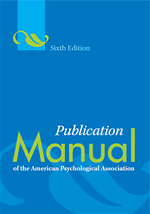The following sections provide you with information and examples that will help you to cite the sources that you come across during your research.
What type of sources do you want to cite?
APA style is the editorial style created by the American Psychological Association that many of the social and behavioral sciences have adopted to present written material in the field. APA Style was first developed 80 years ago by a group of social scientists who wished to establish sound standards of communication. Since that time, it has been adopted by leaders in many fields and has been used by writers around the world.
*From www.apastyle.org
The purpose of documentation is to:
The purpose of this guide is to provide some helpful examples; however, it may not be perfect. For more detailed information, refer to the APA Manual (6th ed.) available at the IRAD (Information & Research Assistance Desk) in the Library; ask your instructor; or AskUs.
 Publication Manual of the American Psychological Association
by
Publication Manual of the American Psychological Association
by
 APA style guide to electronic references
by
APA style guide to electronic references
by
This guide is based on the APA Publication Manual (6th ed.) that was published in 2009. This manual and selections from it are available in the Library; click the links below to view them in our catalogue.
The following sites also provide helpful citation examples:
Many scholarly publishers now assign an alpha-numeric code called a DOI (Digital Object Identifier) to journal articles and other documents. APA guidelines for citing electronic resources include this number in the citation whenever possible. The DOI can generally be found on the first page of scholarly journal articles as well as in the database record for that article.
If the DOI does not appear on the article or in the database record, it may be found by entering citation information into the free DOI Lookup on CrossRef.org.
To determine DOIs for an entire reference list, copy & paste the entire list here: Cross/Ref Simple Text Query.
Materials originally published prior to the Internet, but now available online, may not have a DOI. Use this DOI Flow Chart created by APA to help you decide what information you need to include if you cannot find a DOI.
The official companion blog to the APA Style, 6th Edition. Published weekly, various experts examine "what APA Style is and how it works in a variety of areas, including reference citations of every sort, grammar and usage, the publication process, and social media" (About Us, 2009).
Acknowledgement
This guide was created using a template from Red Deer College, and draws from content created by ULethbridge Librarian Judy Vogt.